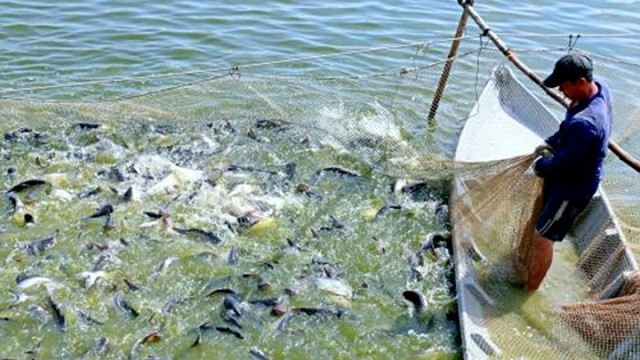Boosting innovation, overcoming barriers
According to the Ministry of Agriculture and Rural Development (MARD), in 2018, pangasius export turnover reached the highest level ever, at US$2.26 billion, up 26.4% compared to 2017 and 15% compared to the set plan.
Statistics from the MARD’s Directorate of Fisheries showed that the pangasius farming areas of the whole country in 2018 reached 5,400 ha, up 3.3%, while output reached 1.42 million tonnes, an increase of 8.4% compared to 2017. Several key pangasius farming provinces reached high outputs, namely Dong Thap, roughly 452,000 tonnes, up 3.7% over the same period, An Giang 333,200 tonnes, up 36% and Ben Tre 182,000 tonnes, up 3.1%.
Along with the increase in farming area and production output, the price of raw pangasius in the Mekong Delta in 2018 also reached a high level. On average, the price for tra fish production was around VND21,000/kg, while the price of commercial tra fish during its peak was from VND35,000-36,000 per kg, bringing great profit for farmers. A few years ago, they suffered losses, but in 2018, many of them were able to revive farming as well as improving income thanks to good yields and high prices of tra fish.
One of the biggest victories of the Vietnamese pangasius industry in the past year was the effort to overcome many trade and technical barriers imposed by importing countries. Specifically, the Vietnamese pangasius has regained its credit from consumers in the European market after a long time being reported by the regional media with inaccurate and adverse information, that negatively affected the image of Vietnamese pangasius in the region and the world market in general. Currently, frozen pangasius products and processed pangasius from Vietnam have been sold in multiple supermarkets in France, Spain, and Germany, with a good response from local consumers. The consumption of tra fish in the European market in 2018 reached roughly US$231.3 million, up 19.1% compared to 2017.
Vietnamese pangasius products also surpassed the strict technical barriers of the US as the US States Department of Agriculture (USDA) recognised the pangasius farming process in Vietnam similar to that of catfish raising in the US. Previously, according to US regulations, exporters wanting to export pangasius to this market had to comply with the whole process in an “America style” in creating products, from the first (seed, feed) to the last stage. The time to implement the conversion process was 18 months, from March 2016. This was a big challenge for the Vietnam pangasius industry at that time. However, with Vietnam’s efforts to comprehensively innovate the whole industry, by 2018, after the actual inspection in Vietnam, the USDA Food Safety and Inspection Service proposed to recognise Vietnamese tra and basa fishes as having a quality control system comparable to US catfish, and qualified to export to the US. This is an important factor that made the US become the market with the highest growth rate in 2018 for Vietnamese pangasius, with a growth rate of 57.7%, surpassing China and returning to the world No. 1 position in consuming Vietnamese pangasius products.
Increasing quality, value added
Commenting on the breakthrough development of the pangasius industry in 2019, General Secretary of the Vietnam Association of Seafood Exporters and Producers (VASEP) Truong Dinh Hoe said that multiple difficulties have appeared since the end of 2018 and in early 2019. Specifically, it is fierce competition from other countries, such as China, India, Bangladesh, Malaysia, Indonesia in the field of catfish farming. In particular, special emphasis must be placed on China - the country that consumes more than 60% of Vietnam's pangasius, as it has started farming pangasius and harvesting. According to statistics of VASEP, China has raised and harvested 10,000 tonnes of tra fish in Hainan Island. In India, tra fish production reached 650,000 tonnes, while the figures in Bangladesh were 450,000 tonnes and Indonesia 110,000 tonnes. Although the quality of pangasius in these countries is lower than that of Vietnam, the domestic pangasius industry should not ignore the situation.
Another risk for the pangasius industry in 2019 is concern over oversupply or lack of supply. In fact, the price of pangasius began to increase sharply from the beginning of 2017, prolonged and reached its peaked in 2018. This led to massive farming and then surplus in the harvest season. At that time, the price of raw pangasius sold to processing factories slipped, forcing the loss-making farmers to stop farming for the next season, and then resulted in a lack of supply for enterprises to implement export contracts. This cycle is not new, but if there is a lack of synchronous planning and conscious farming, it will surely reoccur and leave unpredictable consequences.
According to VASEP Secretary General of Truong Dinh Hoe, in order for the pangasius industry to maintain its growth momentum, there should be clear solutions, in which the quality of pangasius must still be the main focus, from seeding and tra fish production to processing products for export. To do so, farming areas must constantly be inspected and monitored, thus ensuring the requirements of production and the farming environment. The preservation of quality recognised by the US must be done regularly and continuously. In addition, it is necessary to focus more on deep processing and diversifying products from pangasius, not only pangasius fillets or frozen pangasius but also for spiced and seasoned pangasius and skewered pangasius - which are popular in Asian markets such as Japan and the Republic of Korea.
Another equally important requirement is to maintain key export markets such as the US, the EU and China, and to open new markets, including the markets in the Middle East region, such as the UAE, Egypt, and Saudi Arabia. In 2018, it is estimated that these markets imported pangasius from Vietnam worth US$290 million and may continue to increase in 2019. Another market segment that should be considered is ASEAN. 2018 also saw a sharp increase in this region with a total export value of nearly US$200 million (up nearly 50% compared to the same period in 2017). In particular, Thailand is the largest market of Vietnamese pangasius in ASEAN, accounting for 36.8% of the total exports. Singapore and the Philippines are also stable import markets and are expected to increase sharply in the near future. In particular, with the Comprehensive and Progressive Agreement for Trans-Pacific Partnership (CPTPP), which has just come into effect, and as Vietnam prepares to sign the EU - Vietnam Free Trade Agreement (EVFTA), Vietnamese pangasius promises to have more opportunities to expand its consumption market globally.
| Vietnam targets to exports pangasius products worth US$2.4 billion (up 6.19% compared to 2018), while maintaining a stable farming area of pangasius with an estimated output of nearly 1.47 million tonnes. For the two major export markets - the US and the EU - the Vietnamese pangasius industry has great potential for increasing profits with ready-to-eat and processed products, because the gross profit margin of these products is from 22-25%, while frozen fish fillet products are only 12-16%. |
















